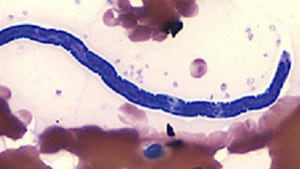Key points
- Loiasis is an infection caused by a parasitic worm.
- It can cause itchy, non-painful swelling in the body.
- The adult worm may move under the conjunctiva of the eye (this is why it is called eye worm)
- Eye worm movement under conjunctiva are brief, painless, and might re occur. It’s spread by deerflies that breed in West and Central Africa.
- There are antiparasitic drugs to treat loiasis.

Overview
Loiasis, also known as African eye worm, is a disease caused by a parasitic worm called Loa loa. A parasite is an organism (a living thing) that lives on or inside another organism. It spreads to people through the repeated bites of deerflies that breed in rain forests in West and Central Africa.
Loiasis has made it harder to eradicate other tropical diseases, since the drugs given to help treat illnesses like onchocerciasis (river blindness) and lymphatic filariasis (elephantiasis) may cause serious side effects in people with a Loa loa infection.
Symptoms
Most people infected with Loa loa do not develop symptoms. But in those who do, symptoms can include
- Itchy, non-painful body swelling that comes and goes. This swelling can show up anywhere, although it’s more likely to be near joints.
- Eye worms, which crawl across the surface of the eye.
- Worms visibly crawling under the skin.
Less common symptoms include
- Itching all over your body
- Muscle pain and joint pain
- Feeling weak and tired (fatigue)
Risk factors
The people most at risk for loiasis are those who live in the certain rain forests in West and Central Africa, where species of deerfly that carry the parasite breed. Deerflies bite during the day and are more common during the rainy season.
People's movements and smoke from wood fires can attract deerflies. You can often find deerflies on or near rubber plantations. They do not typically enter homes, but well-lit homes may attract them.
Travelers are more likely to become infected if they are in areas where they are bitten by deerflies for several months. However, occasionally they get infected even if they are in an affected area for less than 30 days.
Your chances of infection go up if you get more bites, if there are more infected deerflies in the area you visit, and the longer you stay in the area.
How it spreads
People get loiasis from repeated bites from an infectious deerfly carrying the Loa loa parasite. The larvae (immature worms) spread through the blood to the lungs and other organs and develop into adults. The adult worms reproduce microscopic immature worms, called microfilariae, which the deerfly ingest when they feed on an infected person.
Loiasis does not spread directly from person to person.
Prevention
The best way to prevent loiasis is to avoid deerfly bites. If you’re in an area where deerfly are common
- Use Environmental Protection Agency (EPA)-registered insect repellents containing DEET or another EPA-registered active ingredient.
- Wear loose-fitting long-sleeved shirts and pants.
- Avoid wood smoke, which attracts deerflies.
- Keep windows and doors closed or covered with screens to keep biting insects out.
- Repair broken screening on windows, doors, porches, and patios.
If you are going to stay in an area affected by Loa loa for a long period of time, you can reduce your risk of getting loiasis by taking a drug called diethylcarbamazine (DEC). Talk with your healthcare provider or a tropical medicine expert to determine whether using DEC to prevent loiasis is right for you. It can take time to get DEC, so do not wait until the last minute.
Resource
Diagnosis
If you have symptoms of loiasis and have traveled to an area with infected deerflies, your healthcare provider may order a test called a blood smear. A small sample of your blood is collected and examined under a microscope to confirm if you are infected with the Loa loa parasite.
A healthcare provider could also diagnose you with loiasis if they see an adult worm on the surface of your eye.
Treatment
There are risks associated with the different options for treating loiasis. Your healthcare provider may want to work with an expert in infectious or tropical diseases before starting you on treatment. Read more about the different types of treatment for loiasis.
